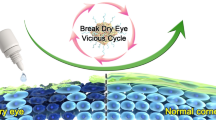Abstract
In the present study, an effort was made to design poly (D, L-lactide-co-glycolide) acid nanoparticles of aceclofenac by direct precipitation method. The nanoparticles were found to have adequate particle size range for ocular administration of 162.6 to 244.13 nm with nearly spherical shape and with zeta potential of − 21.5 to − 25.5 mV. Drug entrapment efficiency of nanoparticle formulations ranged from 42.9 to 92.68%. Differential scanning calorimetric (DSC) and powder X-ray diffraction (PXRD) studies depicted that the drug incorporated in nanoparticles was found to be in amorphous state. Moreover, nanoparticles showed prolonged in vitro drug release profile and followed Higuchi-square-root release kinetics. Nanoparticles showed two folds higher permeation than aqueous solution of aceclofenac. Nanoparticles were well tolerated with no signs of corneal damage in in vitro transcorneal permeation studies. The formulation was quite stable. In vivo ocular anti-inflammatory study in the rabbit eyes confirmed better efficacy of nanoparticles as compared with the aqueous solution and its potential application in ocular inflammatory conditions.



Similar content being viewed by others
References
Schoenwald RD. Controlled drug bioavailability. In: Smolen VF, Bull L, editors. Bioavailability control by drug delivery system design. New York: John Wiley & Sons; 1985. p. 257–306.
Huang Y, Tao Q, Hou D, Hu S, Tian S, Chen Y, et al. A novel ion exchange carrier based upon liposome-encapsulated montmorillonite for ophthalmic delivery of betaxolol hydrochloride. Int J Nanomedicine. 2017;12:1731–45.
Gupta AK, Madan S, Majumdar DK, Maitra A. Ketorolac entrapped in polymeric micelles: preparation, characterization and ocular anti-inflammatory studies. Int J Pharm. 2000;209:1–14.
Katzer T, Chaves P, Bernardi A, Pohlmann A, Guterres SS, Ruver Beck RC. Prednisolone-loaded nanocapsules as ocular drug delivery system: development, in vitro drug release and eye toxicity. J Microencapsul. 2014;31(6):519–28.
Kalomiraki M, Thermos K, Chaniotakis NA. Dendrimers as tunable vectors of drug delivery systems and biomedical and ocular applications. Int J Nanomedicine. 2015;11:1–12.
Araujo J, Vega E, Lopes C, Egea MA, Garcia ML, Souto EB. Effect of polymer viscosity on physicochemical properties and ocular tolerance of FB-loaded PLGA nanospheres. Colloids Surf B Biointerfaces. 2009;72:48–56.
Vege E, Gamisans F, Garcia ML, Chauvet A, Lancoulonche F, Egea MA. PLGA nanospheres for ocular delivery of flurbiprofen: drug release and interactions. J Pharm Sci. 2008;97:5306–17.
Ibrahim MM, Abd-Elgawad AH, Soliman OA, Jablonski MM. Stability and ocular pharmacokinetics of celecoxib-loaded nanoparticles topical ophthalmic formulations. Pharm Sci. 2016;105:3691–701.
Agnihotri SM, Vavia PR. Diclofenac-loaded biopolymeric nanosuspensions for ophthalmic application. Nanomedicine. 2009;5:90–5.
Parra A, Mallandrich M, Clares B, Egea MA, Espina M, García ML, et al. Design and elaboration of freeze-dried PLGA nanoparticles for the transcorneal permeation of carprofen: ocular anti-inflammatory applications. Colloids Surf B Biointerfaces. 2015;136:935–43.
Searle AE, Pearce JL, Shaw DE. Topical use of indomethacin on the day of cataract surgery. Br J Ophthalmol. 1990;74:19–21.
Copper LA, Bergamini MV, Leopold IH. Use of flurbiprofen to inhibit corneal neovascularization. Arch Ophthalmol. 1980;98:1102–5.
Gaynes BI, Fiscella R. Topical nonsteroidal antiinflammatory drugs for ophthalmic use: a safety review. Drug Saf. 2002;25:233–50.
Grau M, Montero JL, Guasch J, Felipe A, Carrasco E, Julia S. The pharmacological profile of aceclofenac, a new non steroidal anti-inflammatory and analgesic drug. Agents Actions Suppl. 1991;32:125–9.
Hinz B, Auge D, Rau T, Rietbrock S, Brune K, Werner U. Simultaneous determination of aceclofenac and three of its metabolites in human plasma by high performance liquid chromatography. Biomed Chromatogr. 2003;17:268–75.
Dooley M, Spencer CM, Dunn CJ. Aceclofenac: a reappraisal of its use in the management of pain and rheumatic disease. Drugs. 2001;61:1351–78.
Katara R, Sachdeva, Majumdar DK. Aceclofenac oil drops: characterization and evaluation against ocular inflammation. Pharm Dev Technol. 2017;19:1-7. doi:10.1080/10837450.2017.1337794
Mathurm M, Gilhotra RM. Glycerogelatin-based ocular inserts of aceclofenac: physicochemical, drug release studies and efficacy against prostaglandin E2-induced ocular inflammation. Drug Deliv. 2011;18(1):54–64.
Katara R, Majumdar DK, Eudragit RL. 100-based nanoparticulate system of aceclofenac for ocular delivery. Colloids Surf B Biointerfaces. 2013;1:455–62.
Abelson MB, Butrus SI, Kliman GH, Larson DL, Corey EJ, Smith LM. Topical arachidonic acid: a model for screening anti-inflammatory agents. J Ocul Pharmacol. 1987;3:63–74.
Sood R. Medical Laboratory Technology: methods and interpretations. 4th edition. Jaypee Brothers; 1999. p. 169-237.
Panda A, Meena J, Katara R, Majumdar DK. Formulation and characterization of clozapine and risperidone co-entrapped spray-dried PLGA nanoparticles. Pharm Dev Technol. 2016;21(1):43–53.
Cegnar M, Kos J, Kristl J. Cystatin incorporated in poly (lactide-coglycolide) nanoparticles: development and fundamental studies on preservation of its activity. Eur J Pharm Sci. 2004;22:357–64.
Luk CL, Youqin T. Zeta potential. In: Swarbrick J, Boylan JC, editors. Encyclopedia of pharmaceutical technology. New York: Marcel Dekker Inc; 1992.
Malhotra M, Majumdar DK. Permeation through cornea. Indian J Exp Biol. 2001;39:11–24.
Costa P, Loba JMS. Modeling and comparison of dissolution profiles. Eur J Pharm Sci. 2001;13:123–33.
Mohamed QG, Hideo U, Johnny Y, Jasmine D, Labhasetwar V, Lee VH. The characteristics and mechanisms of uptake of PLGA nanoparticles in rabbit conjunctival epithelial cell layers. Pharm Res. 2004;21:641–8.
Srinivasan BD, Kulkarni PS. The role of arachidonic acid metabolites in the mediation of the polymorphonuclear leukocyte response following corneal injury. Invest Ophthalmol Vis Sci. 1980;19:1087–93.
Pignatello R, Ricupero N, Bucolo C, Maugeri F, Maltese A, Puglisi G. Preparation and characterization of Eudragit retard nanosuspensions for the ocular delivery of cloricromene. AAPS PharmSciTech. 2006;7:192–8.
Acknowledgements
Authors are thankful to Govt. of NCT, New Delhi, India for providing fellowship to Rajesh Katara and Ranbaxy Laboratories Ltd. (Gurgaon, India) for gifting aceclofenac bulk drug. Thanks are also due to the National Institute of Immunology (New Delhi, India) for gifting PLGA and SAIF at AIIMS (New Delhi) for TEM.
Author information
Authors and Affiliations
Corresponding author
Ethics declarations
Conflict of interest
Authors Rajesh Katara, Sameer Sachdeva, and Dipak K Majumdar declare that they have no conflict of interest.
Animal studies
All institutional and national guidelines for the care and use of laboratory animals were followed.
Rights and permissions
About this article
Cite this article
Katara, R., Sachdeva, S. & Majumdar, D.K. Enhancement of ocular efficacy of aceclofenac using biodegradable PLGA nanoparticles: formulation and characterization. Drug Deliv. and Transl. Res. 7, 632–641 (2017). https://doi.org/10.1007/s13346-017-0416-1
Published:
Issue Date:
DOI: https://doi.org/10.1007/s13346-017-0416-1




